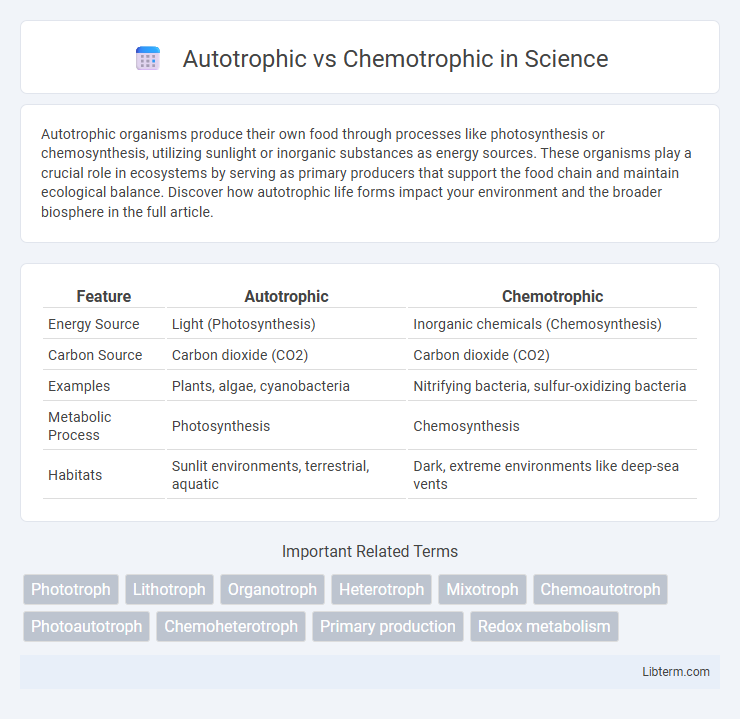Autotrophic organisms produce their own food through processes like photosynthesis or chemosynthesis, utilizing sunlight or inorganic substances as energy sources. These organisms play a crucial role in ecosystems by serving as primary producers that support the food chain and maintain ecological balance. Discover how autotrophic life forms impact your environment and the broader biosphere in the full article.
Table of Comparison
| Feature | Autotrophic | Chemotrophic |
|---|---|---|
| Energy Source | Light (Photosynthesis) | Inorganic chemicals (Chemosynthesis) |
| Carbon Source | Carbon dioxide (CO2) | Carbon dioxide (CO2) |
| Examples | Plants, algae, cyanobacteria | Nitrifying bacteria, sulfur-oxidizing bacteria |
| Metabolic Process | Photosynthesis | Chemosynthesis |
| Habitats | Sunlit environments, terrestrial, aquatic | Dark, extreme environments like deep-sea vents |
Introduction to Metabolic Strategies
Autotrophic organisms synthesize organic compounds using inorganic carbon sources, primarily through photosynthesis or chemosynthesis, enabling energy capture from sunlight or chemical reactions. Chemotrophic organisms derive energy by oxidizing chemical compounds, which may be organic or inorganic, facilitating survival in diverse environments lacking sunlight. These metabolic strategies underpin ecological energy flow and influence nutrient cycling across ecosystems.
Defining Autotrophs: Key Characteristics
Autotrophs are organisms that synthesize their own organic compounds from inorganic sources using light (photoautotrophs) or chemical energy (chemoautotrophs) as an energy source. They possess key characteristics including the ability to fix carbon dioxide through processes like photosynthesis or chemosynthesis, enabling them to serve as primary producers in ecosystems. Autotrophs play a critical role in carbon cycling and form the base of most food chains by generating biomass essential for heterotrophic organisms.
Understanding Chemotrophs: Core Features
Chemotrophs obtain energy by oxidizing inorganic or organic molecules, distinguishing them from autotrophs that primarily rely on sunlight through photosynthesis. Key features of chemotrophs include their ability to thrive in environments lacking light, such as deep-sea vents or soil, by utilizing chemical energy sources like hydrogen sulfide, ammonia, or iron ions. This metabolic versatility supports various ecological roles, including nutrient cycling and supporting ecosystems independent of solar energy.
Types of Autotrophic Organisms
Autotrophic organisms primarily include photoautotrophs and chemoautotrophs, with photoautotrophs like plants, algae, and cyanobacteria using sunlight to synthesize organic compounds through photosynthesis. Chemoautotrophs, such as nitrifying bacteria, sulfur-oxidizing bacteria, and iron-oxidizing bacteria, obtain energy by oxidizing inorganic molecules like ammonia, hydrogen sulfide, or ferrous ions. These autotrophs form the base of many ecosystems by producing organic matter independently of organic nutrients.
Types of Chemotrophic Organisms
Chemotrophic organisms obtain energy by oxidizing inorganic or organic compounds, with key types including chemoautotrophs and chemoheterotrophs. Chemoautotrophs, such as nitrifying bacteria (Nitrosomonas and Nitrobacter), oxidize inorganic molecules like ammonia or nitrites to fix carbon dioxide, playing crucial roles in nitrogen cycling. Chemoheterotrophs, including many bacteria and archaea, derive both energy and carbon from organic compounds, commonly found in decomposers and pathogens.
Energy Sources: Light vs Chemical Compounds
Autotrophic organisms harness energy primarily from light through photosynthesis, converting solar energy into chemical energy stored in organic molecules. Chemotrophic organisms obtain energy by oxidizing chemical compounds such as hydrogen sulfide, ammonia, or iron, relying on inorganic or organic molecules as electron donors. The distinction in energy sources fundamentally influences their metabolic pathways and ecological roles in nutrient cycling.
Ecological Roles and Importance
Autotrophic organisms, such as plants and cyanobacteria, convert inorganic carbon dioxide into organic matter using sunlight through photosynthesis, forming the base of most ecosystems and supporting food webs. Chemotrophic organisms, including certain bacteria and archaea, obtain energy by oxidizing inorganic or organic chemicals, playing vital roles in nutrient cycling, such as nitrogen fixation, sulfur oxidation, and methane production in diverse environments. These metabolic strategies drive primary production and biogeochemical processes essential for ecosystem stability and nutrient availability.
Examples of Autotrophs and Chemotrophs
Autotrophs such as cyanobacteria, plants like maize, and algae harness sunlight to produce energy through photosynthesis, converting carbon dioxide into organic compounds. Chemotrophs include nitrifying bacteria and sulfur-oxidizing bacteria that obtain energy by oxidizing inorganic molecules like ammonia or hydrogen sulfide in environments devoid of sunlight. These distinct metabolic strategies highlight the ecological roles of autotrophs as primary producers and chemotrophs as key players in nutrient cycles.
Adaptations and Survival Mechanisms
Autotrophic organisms, such as plants and cyanobacteria, have evolved photosynthetic pigments and efficient light-harvesting complexes to optimize energy capture from sunlight, enabling survival in diverse light environments. Chemotrophic organisms utilize specialized enzymes and metabolic pathways to extract energy from inorganic or organic chemical compounds, adapting to habitats where light is unavailable, such as deep-sea vents and sulfur-rich soils. These distinct biochemical adaptations ensure both autotrophs and chemotrophs maintain energy production and growth under varying environmental conditions.
Autotrophic vs Chemotrophic: Key Differences and Applications
Autotrophic organisms synthesize their own organic compounds using inorganic sources like carbon dioxide, primarily through photosynthesis or chemosynthesis, while chemotrophic organisms obtain energy by oxidizing inorganic or organic chemicals without relying on sunlight. Key differences lie in their energy sources, with autotrophs harnessing light or chemical energy to fix carbon, and chemotrophs primarily using chemical reactions for energy metabolism. Applications of autotrophic processes include agricultural productivity and biofuel production, whereas chemotrophic metabolism plays a crucial role in bioremediation and industrial biochemical synthesis.
Autotrophic Infographic

 libterm.com
libterm.com